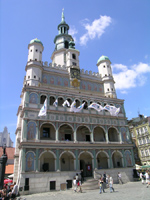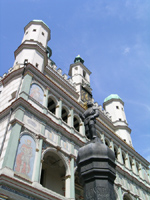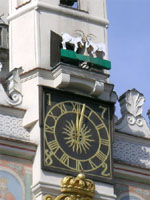Centrum Doradztwa Zawodowego
- Działalność Centrum
- Aktualności
- Poradnik dla absolwenta
- Kursy i szkolenia
- Katalog linków
- Dokumenty aplikacyjne
Artukuły
Contact
Town Hall
Formerly seat of the city council, one of the most valuable Renaissance architecture monuments in central Europe.
The earliest mention about it dates back to 1310. It must have been erected shortly before that, at the turn of the 13th century. Evidence of that is a keystone preserved in the cellar that bears the coat of arms of the Przemyślid dynasty, represented on the Polish throne from 1300 to 1306 by Waclaw II. The Gothic town hall was at first an unimposing two - storey building and the tall tower was most probably not built until the early 16th century.
Between 1550 and 1567 the town hall was reconstructed in the Renaissance style by the Italian architect Giovanni Batista Quadro of Lugano. The building was extended to the west and raised by one floor, its roofs were hidden behind attic storeys and its facade decorated with a three - storey loggia. In 1675 the tower was struck by lightning and destroyed. It was rebuilt in 1690, but in 1725 it was felled again, this time by gale force winds.
The new classicist cupola with an eagle was mounted on the tower only during the general renovation of the building, carried out in the years 1781-84 under the auspices of the Good Order Committee. During the next renovation between 1910 and 1913 an extra storey was added. In 1945 the town hall suffered serious damage: the cupola of the tower came down and the top two floors were completely burnt.
The most valuable interiors on the first floor were saved from fire by the city custodian, Józef Jóźwiak. During the reconstruction, which lasted until 1954, the extra storey added at the beginning of the century was demolished. In 1994 the work on general renovation of the town hall was started.
The town hall elevations are consistent in their Renaissance character. The only evidence of the building's Gothic past is the brick fragment of the tower dating back to the early 16th century. The classicist cupola was restored to its form from the end of the 18th century. Perched on its top is an original eagle from 1783. It is 1.8 metres high and has a wingspan of 2 metres.
But the building's most attractive feature is its front elevation with its colonnaded three - storey loggia and the three turrets above it. The medallions between the first and the second floor portray heads of wise men and heroes of antiquity. The attic storey features heads of the Polish kings from the Jagiellonian dynasty. Pictures of the kings from the Piast dynasty, designed by Zbigniew Bednarowicz, started to be posted below the side turrets.
In the centre turret, under the clock, there is a cartouche with the initials of king Stanislaus Augustus. Right above the clock there is a small ledge where every day at noon a pair of billy goats appears.
The oldest part of the building is the early - Gothic cellars with their groined - rib vaulting. The most interesting rooms are on the first floor. The Great Hall (also known as the Renascence Room) boasts one of the most beautiful Renaissance interiors in Poland. It has richly decorated coffered sail vaulting that rests on two pillars. Inside one of the ceiling coffers is the coat of arms of Poznań. In the room's west wall there are two late - Gothic portals from 1508. The Royal Room, with barrel vaulting with lunettes, was where the city council used to convene. Its name, which originated in the 17th century, comes from the royal portraits that hang on its walls. The Renaissance fireplace from 1541 was transferred here from the Municipal Scales building, which was being demolished at that time. The Court Room has Renaissance ceiling from the middle of the 16th century; the polychromy that adorns it dates back to different periods, from the 16th to the 19th century. Inside the room stands a statue of king Stanislaus Augustus made in 1791 most probably by Augustin Schöps. The rooms on the second floor have Renaissance ceilings that were restored after WWII. The town hall houses the Poznań History Museum.


